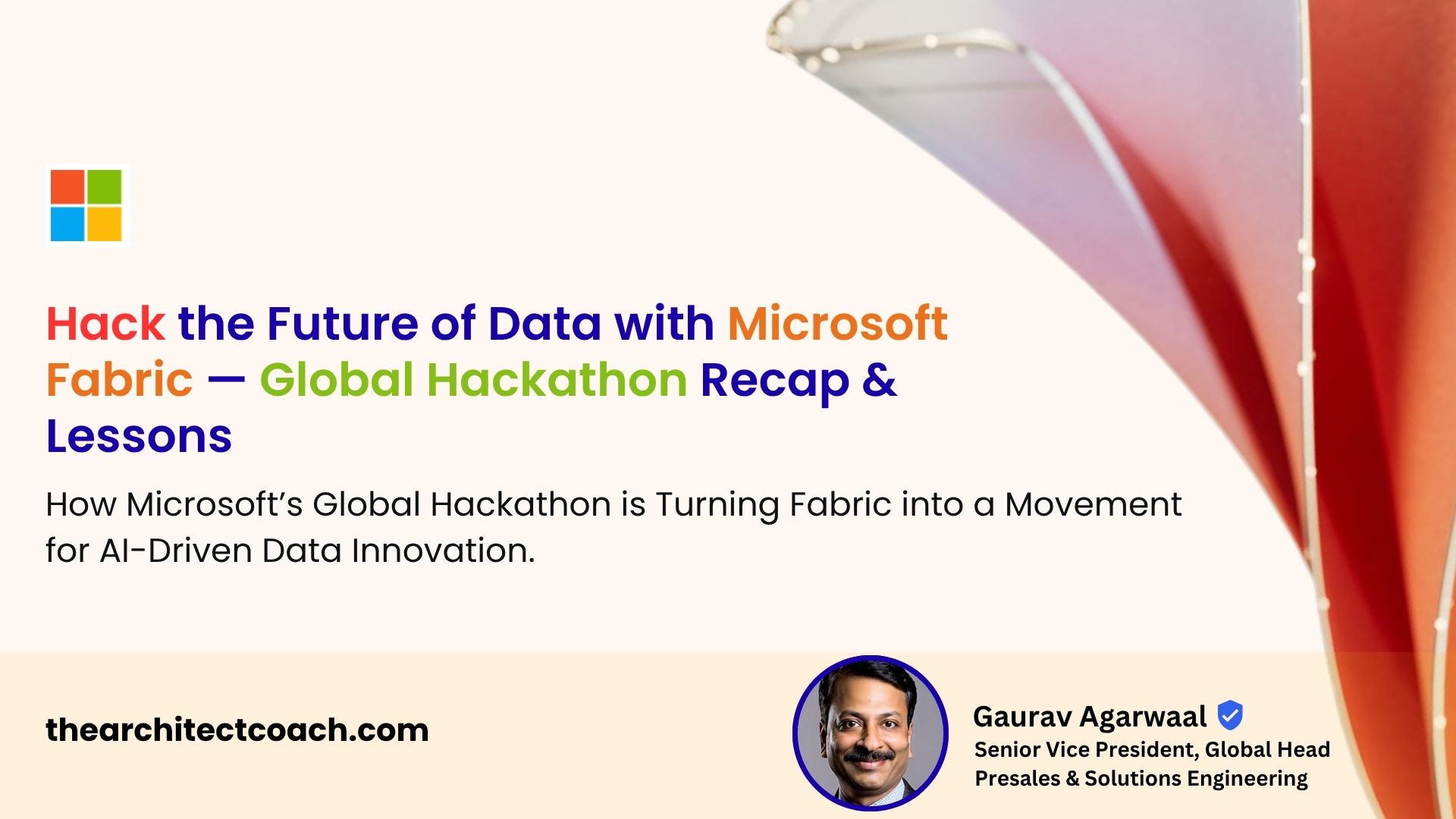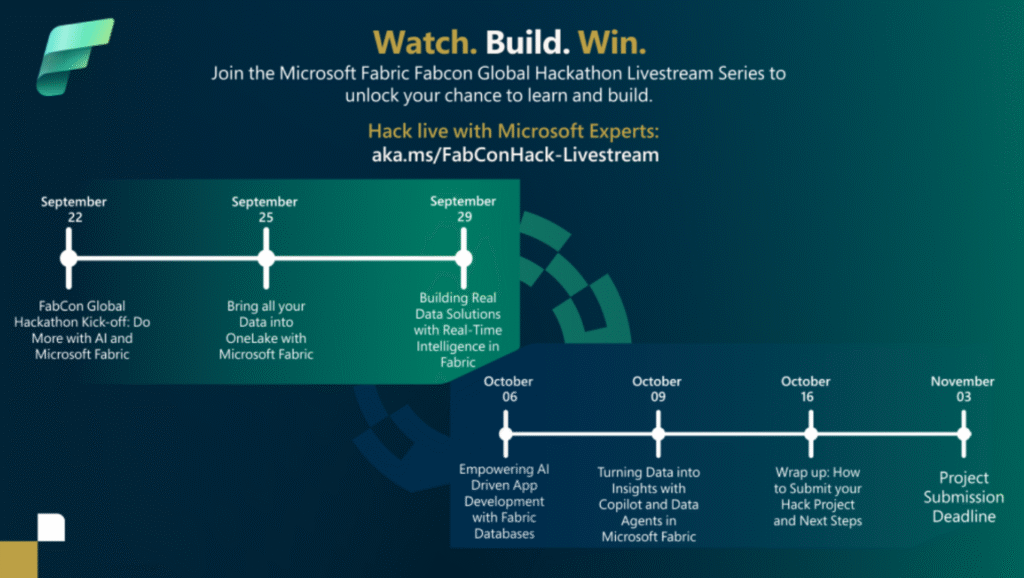A Global Call to Build the Future of Data and AI
Vienna set the stage on September 15, 2025, as the Microsoft Fabric Community Conference launched something far bigger than a developer contest — a global movement.
The “Hack the Future of Data with Microsoft Fabric” hackathon invited builders, students, and professionals to shape the next generation of AI-driven data solutions. Running virtually through November 3, 2025, this worldwide challenge transformed curiosity into capability, showcasing how Fabric can democratize AI innovation at scale.
Thousands joined from every region — data engineers testing the limits of OneLake, AI developers experimenting with Copilot and Data Agents, and first-time makers discovering that Fabric lets you build real-world AI in hours, not months.
“Hackathons are the purest proof of platform maturity. When your community can innovate faster than your roadmap, you’ve built something extraordinary.”
— Gaurav Agarwaal
Microsoft Fabric: The Platform Behind the Movement
This hackathon wasn’t simply a coding sprint — it was a live demonstration of Fabric’s unified data foundation.
Participants built on the same pillars that power enterprise deployments:
- OneLake as the universal data substrate.
- Real-Time Intelligence for event-driven decisions.
- Purview integration for embedded governance.
- Copilot and Data Agents for generative insights.
The structure of the hackathon made learning accessible for all. Microsoft released a Fabric & FabCon Skilling Plan, six livestream training sessions, and open instructions for provisioning Fabric capacity. Each participant — whether individual or team — could register, complete the learning modules, and start building.
And with a $10,000 global prize pool and exposure across Microsoft’s blogs and social channels, the incentive was both educational and aspirational.
My Pick of Top Highlights: Innovation, Inclusion, and Impact
1️⃣ A Democratized Innovation Platform
One of the most defining aspects of this hackathon was accessibility.
Developers could register for free, provision Fabric capacity, and build end-to-end data + AI applications using the same tools Fortune 500 enterprises use daily.
Teams of up to three collaborated remotely — connected through the global Fabric Hackathon Discord Channel, where Microsoft experts mentored participants in real time.
“Fabric has lowered the barrier to innovation so much that a student in Singapore and an architect in Seattle can build together like they’re in the same room.”
— Gaurav Agarwaal
Learning Enablement:
Six guided livestreams between September 22 and October 16 walked participants through the key competencies of Fabric — from OneLake ingestion to AI-assisted development:
- Do More with AI and Microsoft Fabric — Kick-off keynote
- Bring All Your Data into OneLake
- Building Real Data Solutions with Real-Time Intelligence
- Empowering AI-Driven App Development with Fabric Databases
- Turning Data into Insights with Copilot and Data Agents
- Final Wrap-Up and Submission Workshop
Each session blended education with enablement — giving participants the same playbook Microsoft uses to train its internal Fabric engineering teams.
2️⃣ Innovation Aligned to Real-World Value
The hackathon’s design reflected Fabric’s multi-domain versatility — with six official categories mirroring the platform’s core innovation themes:
| Category | Prize | Focus |
| Grand Prize | $2,500 | Best AI + Data Integration |
| Best AI App | $1,500 | Copilot, Data Agents, AI Foundry |
| Best Real-Time Intelligence | $1,500 | Streaming, Alerts, Decisions |
| Best Use of AI Features | $1,500 | Copilot, SynapseML |
| Best Analytics with Fabric DBs | $1,500 | SQL, Cosmos, Graph |
| Best Open Mirroring | $1,500 | Cross-System Integration |
- Grand Prize Winner ($2,500): The most impactful, AI-integrated solution using Fabric end to end.
- Best AI Application with Microsoft Fabric ($1,500): Showcasing Data Agents, AI Foundry, or Copilot Studio to create intelligent apps.
- Best Use of Real-Time Intelligence ($1,500): Harnessing live data sources like Event Hubs, Kafka, or CDC databases for streaming decisions.
- Best Use of AI Features within Fabric ($1,500): Using Copilot, AutoML, SynapseML, or Data Agents to accelerate analysis.
- Best Analytics Solution with Fabric or Azure Databases ($1,500): Connecting Fabric SQL DB, Cosmos DB, or mirrored sources for analytics.
- Best Use of Open Mirroring ($1,500): Integrating external systems seamlessly into Fabric for AI and analytics scenarios.
Judging Criteria (25% each):
- Category alignment
- Innovation & impact
- Documentation & reproducibility
- Clarity of the video demo
“Every category mirrored a principle of modern data architecture: openness, interoperability, and purpose-built intelligence.”
— Gaurav Agarwaal
3️⃣ Real-Time Intelligence Emerged as the Defining Trend
Among the six themes, Real-Time Intelligence (RTI) became the headline story.
Participants built streaming pipelines that analyzed live telemetry, connected IoT feeds, and triggered Copilot-driven recommendations — all within Fabric’s unified interface.
Technical Insight:
Fabric’s Real-Time Hub combined with Data Activator allowed teams to route streaming events into dashboards and AI pipelines seamlessly — no external ETL tools required.
Enterprise Lesson:
If a three-day hackathon can operationalize real-time intelligence, so can an enterprise. Real-time readiness is no longer a luxury — it’s a competitive baseline.
4️⃣ The Rise of AI-Native Development Workflows
Another breakout category was AI Feature Integration — using Copilot, AI Functions, and Data Agents to augment human capability.
Participants built retrieval-augmented generation (RAG) systems using Eventhouse as a vector store, built forecasting models with SynapseML, and automated pipeline creation through Copilot Studio.
These prototypes didn’t just demonstrate Fabric’s breadth — they showcased the platform’s philosophy: data + AI should coexist natively, not as an add-on.
“AI shouldn’t sit on top of your data stack — it should run through it. Fabric finally makes that architecture real.”
— Gaurav Agarwaal
Unified Theme: Community as the New Cloud Accelerator
The most profound lesson from “Hack the Future of Data” wasn’t technical — it was cultural.
Fabric’s greatest strength lies in how it unites builders. By hosting a hackathon open to anyone — from MVPs to first-time coders — Microsoft transformed its ecosystem into a living laboratory for innovation.
Participants didn’t just write code; they co-created best practices, tested governance boundaries, and redefined what “AI readiness” looks like in real time.
“Fabric’s evolution is being co-authored by its users. Every hack submitted is a roadmap suggestion written in code.”
— Gaurav Agarwaal
What CXOs Should Do Next (Prescriptive)
- Institutionalize Hackathons as Strategy Engines: Use the Fabric hackathon model internally — short, focused innovation sprints tied to measurable outcomes.
- Create a Fabric Innovation Sandbox: Mirror Microsoft’s learning environment with secured Fabric capacity for experimentation.
- Encourage Governance-in-Design: Mandate Purview policies in every prototype. Innovation and compliance must co-develop, not follow sequentially.
- Scale Winning Prototypes: Build a “Hack-to-Prod” pipeline — move validated hackathon solutions into production with CI/CD discipline.
- Invest in Real-Time Readiness: Enable RTI across at least one business process by year-end.
Final Reflections: From Hackathons to Habit
When Microsoft called it “Hack the Future of Data,” it wasn’t a metaphor — it was a preview.
What we witnessed was a platform maturing through participation: AI, analytics, and governance evolving together in an open innovation loop.
As the hackathon concludes on November 3, 2025, and winners are announced on November 10, one insight stands out — Fabric has crossed from being a tool to being an ecosystem.
“The true legacy of this hackathon won’t be the winners; it’ll be the workflows. Because every great idea coded this fall will become enterprise best practice by next spring.”
— Gaurav Agarwaal
Views: 2.3K


